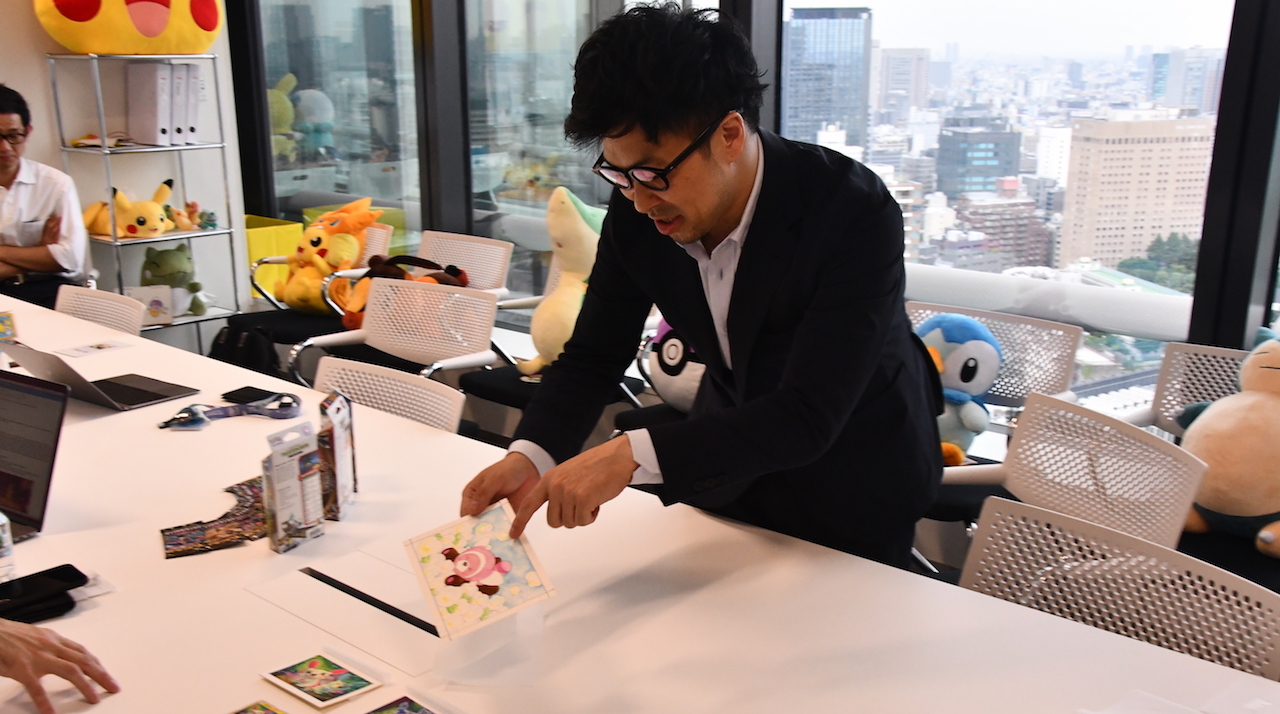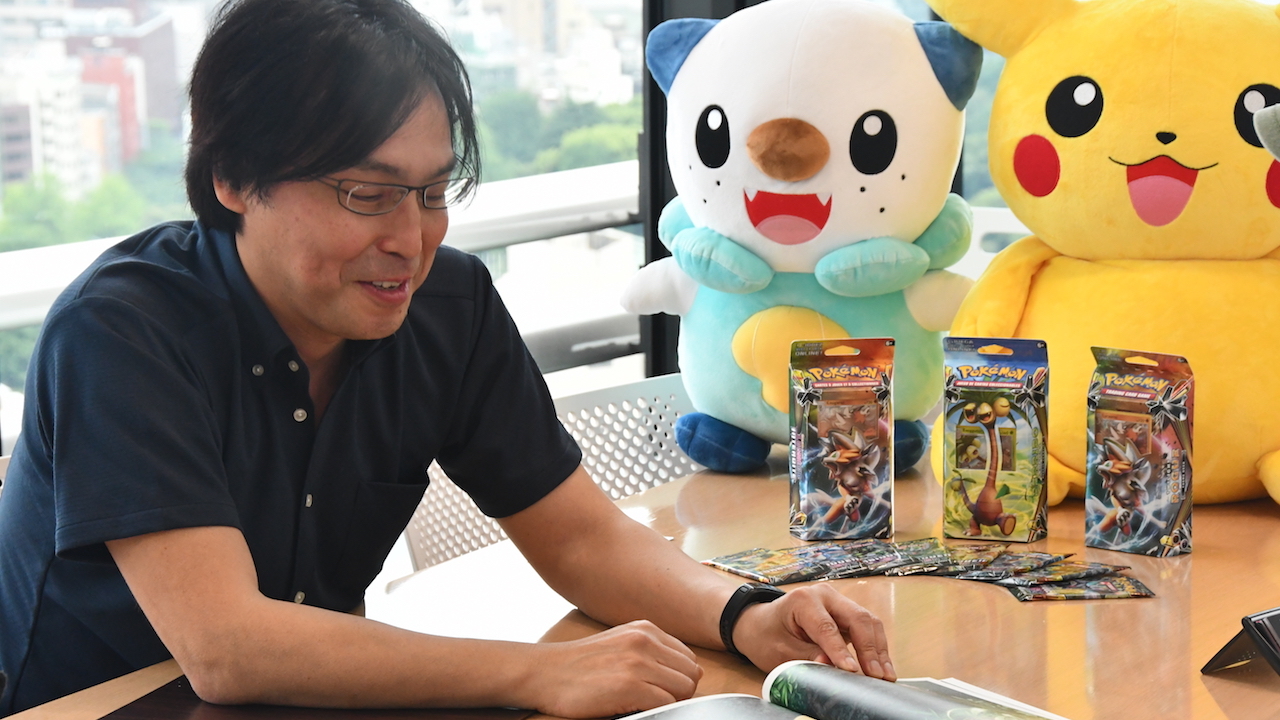Creatures, Inc. is an often-overlooked arm of the Pokemon machine. The developer has worked on spin-off Pokemon games for years, starting with Pokemon Stadium in 1998 and the more recent Detective Pikachu on 3DS--as well as 3D Pokemon models for various games, including Super Smash Bros. But the company is also responsible for much of the Pokemon Trading Card Game, which consistently sees new series and expansions after over 20 years.
We had a chance to tour Creatures Inc.'s Tokyo, Japan office in 2018 to learn about the process of creating Pokemon cards. During our tour, we spoke to Atsushi Nagashima, game director for the TCG, and Mitsuhiro Arita, a longtime freelance illustrator responsible for over 500 Pokemon cards--including the infamous holographic Charizard card--about how cards are conceived and then illustrated. We also talked to Satoru Inoue, the test room lead at Creatures, about how cards are playtested and how balance problems and broken cards are addressed by the team.

There are three main parts to making a new Pokemon card: coming up with the idea for the card, commissioning art, and testing the card with the current TCG rules. This involves a team of game designers, over 70 artists, and 19 playtesters working full time to create and execute new card series and expansions.
Step One: Pick A Pokemon
According to Nagashima, the most important thing when coming up with a new set of cards is variety. There needs to be a mix of art styles and types of cards; some need to have strong competitive potential, while others need to be appealing to collectors. But the first step to creating a new set is deciding which Pokemon to use.
"Near the beginning of a new series [based on the latest video games], we really try to take care to stay true to the video games that we're basing the card series on--for example, the Pokemon that were featured heavily in that video game or had a big role in the story, we'll make sure they're kind of at the center of the set we're making," Nagashima said. "But once we're kind of mid-way through the series, we start focusing more on play environment overall…and decide which Pokemon to put in based on that."
A lot of those choices come down to what the game needs to feel more balanced and what Pokemon suit those needs, Nagashima said. But the team also considers which Pokemon don't get a lot of love in the games or anime, the ones kids might find cool, or even Pokemon they themselves like.
"One of my favorites is Darkrai, and I think you'll notice that there's a lot of strong Darkrai cards," he said, laughing.

There are also background stories and themes for each expansion, though that's not really communicated to players. "In the [XY Breakthrough expansion], the theme we had for that was two parallel worlds. They both featured Mewtwo, so there was a Mewtwo that was in this advanced world...and there was a Mewtwo that was more old-fashioned," Nagashima explained. "These two parallel worlds collide and then the world goes into chaos and is destroyed as a result of that."
According to Nagashima, one of the team's biggest challenges is maintaining the spirit of certain characters and Pokemon while putting their own spin on things. Because the card game is closely tied to the video game, it can also be tricky to translate certain game mechanics into ones that work in the TCG--like Mega Evolution, for example.
"In the trading card game, you have your basic [Pokemon]. You evolve it to Stage 1 and [then Stage 2], so there are two steps to get to your final evolution in general. If we added another step on top of that, you just wouldn't have enough room in your 60-card deck to really make that feasible," Nagashima said. "So we took the approach of only having Mega Evolutions for cards that were already really strong--so there was already an EX card and then that would evolve to the Mega-EX. We tried to reduce the number of steps in that way."
Ultimately, Nagashima says, the TCG team is always trying to keep things fresh and varied while still paying attention to the competitive meta, and it's a complex balancing act even from the beginning.
Step Two: Illustrations
Once the team has decided on the kind of card they need and who (or what) will be on it, it's time to get the art process started. Creatures currently works with 73 different illustrators and artists to ensure sets are varied. One of the most prolific of them is Mitsuhiro Arita, who's been working on the TCG since the beginning and has illustrated 537 cards to date.

Arita showed us his workspace at the Creatures office, part of a pod of desks set up for freelance artists to work on confidential designs. Each desk is configured based on the artists' home offices, usually with tablets for digital art and coloring. He walked us through his illustration process for a recent Lurantis card, paying special attention to dynamic shading and bright background colors to capture the spirit of the Pokemon.
Creatures sends the artists details about the card: what the Pokemon is, the kinds of moves it will have, and any important background information, especially when the Pokemon in question is in a game that hasn't come out yet. This also applies to Trainer cards, and even the vaguest instructions influence the art; for example, Arita received instructions for a Giovanni card with an "imposing" feel, so he gave it a more classical painting style rather than a cartoony one. For holographic cards, Arita will usually specify which parts of his art should shimmer, though the final holo design is a collaboration with Creatures staff.

In the Red and Green days, Arita and the other artists only had the in-game sprites and limited official artwork to work off of when creating cards. Still, he's responsible for some of the most iconic cards from the original series, including holographic Charizard and the original fat Pikachu. In a binder filled with all his designs so far, the first few pages could have been any Pokemon-obsessed kid's collection in the late '90s.
"Specifically this Charizard and that Pikachu are some of the most memorable cards for I think a lot of people who played the game originally, and I always thought that I'd probably never be able to draw cards that people would like better than those two," Arita said. But a Mewtwo-GX card he recently designed is his new favorite, and he says he's been getting good feedback on it.
Unexpectedly, the same artist is unlikely to work on every Pokemon in an evolutionary line. In the original card series, Arita illustrated Bulbasaur and Venusaur but not Ivysaur (which was done by Pokemon artist Ken Sugimori). While there are some cases where a consistent style is called for across an evolutionary line--like these adorable Tepig family cards--they're usually usually split up between artists, presumably for variety or time efficiency.
Efficiency especially is key, since many of the cards go into the testing phase even before the art is finished. If you want to learn even more about the Arita and what goes into creating Pokemon card art, be sure to read our profile on his work.
Step Three: Full-Time Playtesting
At Creatures, there's a special room dedicated to testing the card game. It's in the back of the small office, and it's filled only with tables, chairs, and drawers upon drawers filled with years of Pokemon cards. Seven hours a day, five days a week, 19 playtesters play the TCG to see how new cards fare. (The odd number doesn't seem to be a problem, apparently.)
Because they're mostly testing cards that haven't been released yet, the playtesters have to work with what they have. Work-in-progress cards are actually stickers put on old cards so they can still be played in normal decks; if the illustrations aren't finalized, these stickers will use generic art of the Pokemon (or whatever the card subject is) with the complete moves, name of the card, and suggested effects, HP, and damage.

The playtesters vary in skill to ensure the game is balanced for all levels of players, though all of them are expected to like Pokemon. Most don't take notes, but they do submit reports and have meetings about the cards. Usually, feedback results in very mild tweaks to cards--slightly lower attack damage or bumping up HP by 10 or so. But in the case when a card is broken, the testers will bring that card to the game design team, who will decide how to proceed from there.
According to test room lead Satoru Inoue, those smaller adjustments happen "extremely often," while they'll usually see at most two or three drastic revisions before cards are finalized. Nagashima noted that competitive players will sometimes use released cards in completely unexpected ways, in which case the card has to be banned--he specifically called out Lysandre's Trump Card, which was banned in 2015 for making games severely imbalanced.
Even with all the playtesting, competitive players regularly surprise the team. Nagashima cited Shintaro Ito's Mega Audino deck, which won him the 2016 Pokemon World Championships in the Masters Division, as a recent example--he didn't expect the card to be nearly as viable as it was.

Nagashima's favorite strategy, though, is one he himself was heavily involved in designing: the infamous Night March deck, which dominated much of the competitive scene in 2016 and won the US Nationals that year.
"I was only making it with the assumption that it would maybe make it to the finals, but not take the entire thing!"
Walking back through the office at the end of the tour, nearly every desk is filled with Pokemon toys and merch. It's very clear: From the design and art to the test room, the most important thing for Creatures' TCG team is loving Pokemon.






